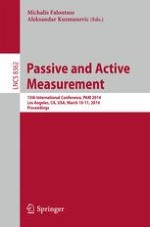2014 | OriginalPaper | Buchkapitel
A Second Look at Detecting Third-Party Addresses in Traceroute Traces with the IP Timestamp Option
verfasst von : Matthew Luckie, kc claffy
Erschienen in: Passive and Active Measurement
Verlag: Springer International Publishing
Aktivieren Sie unsere intelligente Suche, um passende Fachinhalte oder Patente zu finden.
Wählen Sie Textabschnitte aus um mit Künstlicher Intelligenz passenden Patente zu finden. powered by
Markieren Sie Textabschnitte, um KI-gestützt weitere passende Inhalte zu finden. powered by
Artifacts in traceroute measurement output can lead to false inferences of AS-level links and paths when used to deduce AS topology. One traceroute artifact is caused by routers that respond to traceroute probes with a source address not in the path towards the destination, i.e. an off-path address. The most well-known traceroute artifact, the third-party address, is caused by off-path addresses that map to ASes not in the corresponding BGP path. In PAM 2013, Marchetta
et al.
proposed a technique to detect off-path addresses in traceroute paths [14]. Their technique assumed that a router IP address reported in a traceroute path towards a destination was off-path if, in a subsequent probe towards the same destination, the router did not insert a timestamp into a pre-specified timestamp option in the probe’s IP header. However, no standard precisely defines how routers should handle the pre-specified timestamp option, and implementations are inconsistent. Marchetta
et al.
claimed that most IP addresses in a traceroute path are off-path, and that consecutive off-path addresses are common. They reported no validation of their results. We cross-validate their approach with a first-principles approach, rooted in the assumption that subnets between connected routers are often /30 or /31 because routers are often connected with point-to-point links. We infer if an address in a traceroute path corresponds to the interface on a router that received the packet (the in-bound interface) by attempting to infer if its /30 or /31 subnet mate is an alias of the previous hop. We traceroute from 8 Ark monitors to 80K randomly chosen destinations, and find that most observed addresses are configured on the in-bound interface on a point-to-point link connecting two routers, i.e. are on-path. Because the technique from [14] reports 70.9%–74.9% of these addresses as being off-path, we conclude it is not reliable at inferring which addresses are off-path or third-party.
